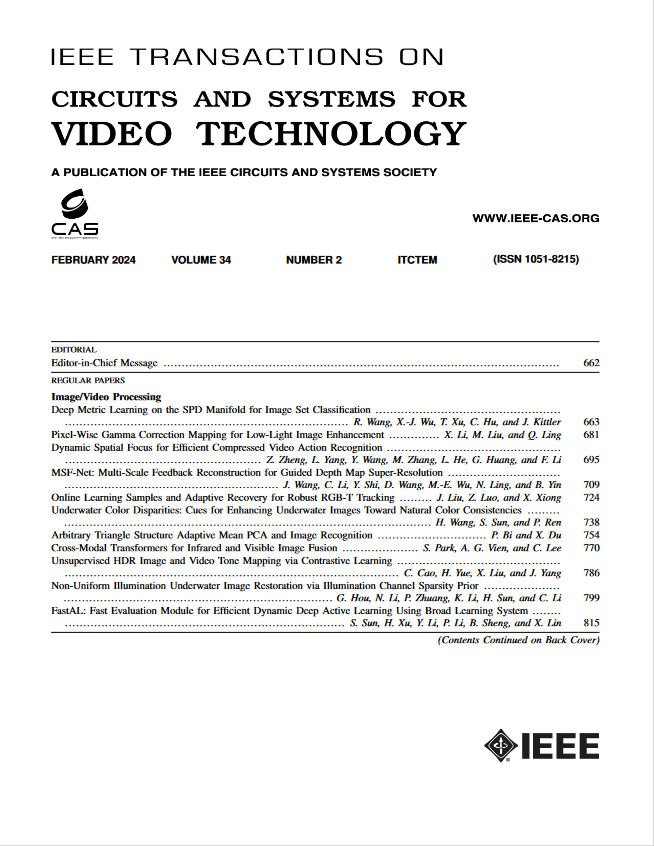Unsupervised Salient Object Detection on Light Field With High-Quality Synthetic Labels
IF 8.3
1区 工程技术
Q1 ENGINEERING, ELECTRICAL & ELECTRONIC
IEEE Transactions on Circuits and Systems for Video Technology
Pub Date : 2024-12-11
DOI:10.1109/TCSVT.2024.3514754
引用次数: 0
Abstract
Most current Light Field Salient Object Detection (LFSOD) methods require full supervision with labor-intensive pixel-level annotations. Unsupervised Light Field Salient Object Detection (ULFSOD) has gained attention due to this limitation. However, existing methods use traditional handcrafted techniques to generate noisy pseudo-labels, which degrades the performance of models trained on them. To mitigate this issue, we present a novel learning-based approach to synthesize labels for ULFSOD. We introduce a prominent focal stack identification module that utilizes light field information (focal stack, depth map, and RGB color image) to generate high-quality pixel-level pseudo-labels, aiding network training. Additionally, we propose a novel model architecture for LFSOD, combining a multi-scale spatial attention module for focal stack information with a cross fusion module for RGB and focal stack integration. Through extensive experiments, we demonstrate that our pseudo-label generation method significantly outperforms existing methods in label quality. Our proposed model, trained with our labels, shows significant improvement on ULFSOD, achieving new state-of-the-art scores across public benchmarks.高质量合成标签光场无监督显著目标检测
当前大多数光场显著目标检测(LFSOD)方法都需要耗费大量劳动的像素级注释来进行全面监督。无监督光场显著目标检测(Unsupervised Light Field Salient Object Detection, ULFSOD)正是由于这一局限性而受到关注。然而,现有的方法使用传统的手工制作技术来生成有噪声的伪标签,这降低了在伪标签上训练的模型的性能。为了解决这个问题,我们提出了一种新的基于学习的方法来合成ULFSOD的标签。我们介绍了一个突出的焦点堆栈识别模块,该模块利用光场信息(焦点堆栈、深度图和RGB彩色图像)生成高质量的像素级伪标签,帮助网络训练。此外,我们还提出了一种新的LFSOD模型架构,该模型将用于焦点堆栈信息的多尺度空间关注模块与用于RGB和焦点堆栈集成的交叉融合模块相结合。通过大量的实验,我们证明我们的伪标签生成方法在标签质量上明显优于现有的方法。我们提出的模型,用我们的标签训练,在ULFSOD上显示出显着的改进,在公共基准测试中获得了新的最先进的分数。
本文章由计算机程序翻译,如有差异,请以英文原文为准。
求助全文
约1分钟内获得全文
求助全文
来源期刊
CiteScore
13.80
自引率
27.40%
发文量
660
审稿时长
5 months
期刊介绍:
The IEEE Transactions on Circuits and Systems for Video Technology (TCSVT) is dedicated to covering all aspects of video technologies from a circuits and systems perspective. We encourage submissions of general, theoretical, and application-oriented papers related to image and video acquisition, representation, presentation, and display. Additionally, we welcome contributions in areas such as processing, filtering, and transforms; analysis and synthesis; learning and understanding; compression, transmission, communication, and networking; as well as storage, retrieval, indexing, and search. Furthermore, papers focusing on hardware and software design and implementation are highly valued. Join us in advancing the field of video technology through innovative research and insights.

 求助内容:
求助内容: 应助结果提醒方式:
应助结果提醒方式:


